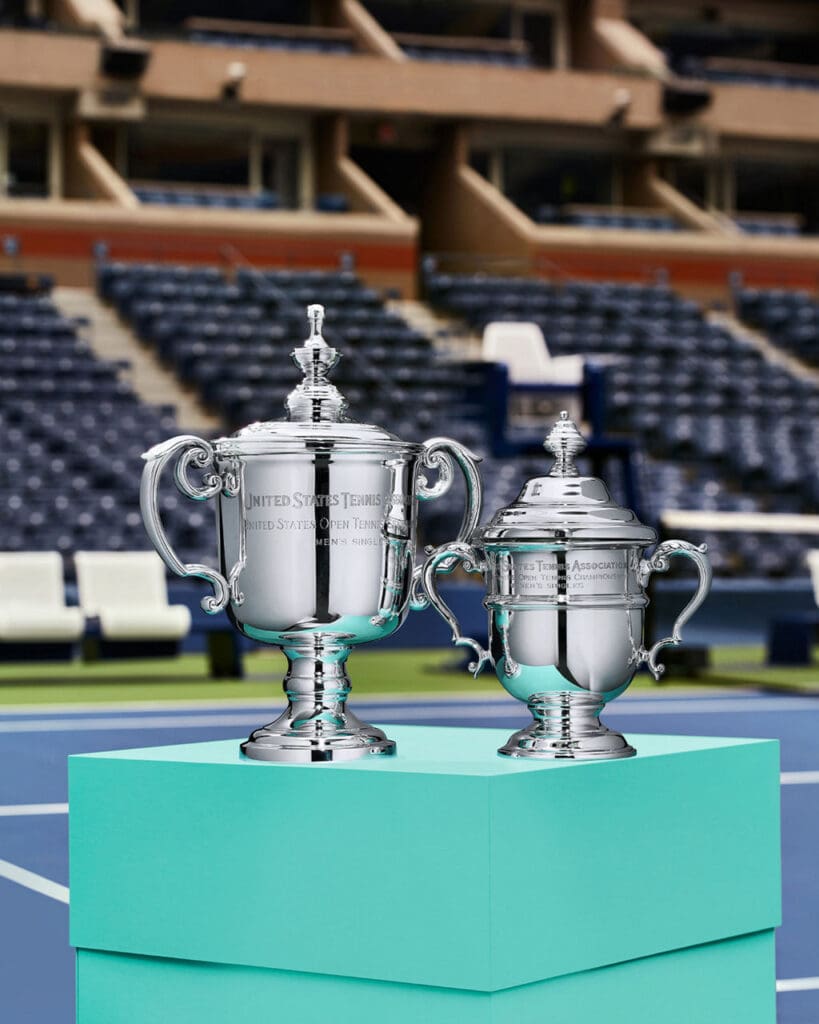The U.S. Open has long been a proving ground for tennis and for the brands that orbit it. This year, Tiffany & Co. returns to the USTA Billie Jean King National Tennis Center for a third consecutive run, installing an immersive pop-up in the Fountain Plaza that makes a clear case for old-world craft in a hyper-activated sports environment. The air hums with the low roar of day-session crowds while polished silver throws back the late-summer light.
At the heart of the space are the Men’s and Women’s Singles Championship trophies, produced by the silversmiths at Tiffany’s hollowware workshop in Cumberland, Rhode Island. The cups stand roughly 18 inches tall, weigh nearly nine pounds, and read as classic American trophy design: confident profiles, crisp handles, mirror-finish surfaces. They are realized through techniques that predate professional tennis itself, including spinning, silversmithing, chasing, hand-engraving, and meticulous polishing. Each trophy takes about six months to complete, with 66 hours of handwork attending every curve and letterform. Up close you see the sharpness of the engraving, the way the light pools in the belly of the bowl, the slight whisper of cloth on silver as staff make final touch-ups.

Tiffany’s relationship with sport is not a recent flirtation. The house began trophy-making in the 19th century with the Woodlawn Vase for the Preakness Stakes in 1860, then spent the next century and a half shaping American victory into silver form. Its workshop is behind the Vince Lombardi Trophy for the Super Bowl, the Larry O’Brien Trophy for the NBA Finals, silverware for the PGA Tour, and the hardware for the Miami Grand Prix. The brand also stepped into digital-native territory with the Summoner’s Cup for the League of Legends World Championship in 2022, and even collaborated with MSCHF on a puckish “Ultimate Participation Award.” Today, the tally sits at about 65 trophies a year, including the pair that will cap the Open.
The pop-up does not stop at heritage. A one-of-one tennis racket, inspired by Tiffany HardWear, is set with nearly 5 carats of diamonds, its metallic geometry catching the plaza’s sunlight like sequins on a stage. Beside it sits a 24-karat gold vermeil tennis ball, its seams lined with almost 7 carats of stones. The effect is theatrical, a glittering wink at a sport that has leaned into fashion and jewelry with increasing comfort. You would not take it to the practice courts, but you might remember it long after the final tie-break.

There is also an A.I. experience built with Meta that invites visitors to visualize themselves as center court contenders and leave with a digital takeaway. It is an obvious piece of brand theater, though a smart one, blending the selfie economy with a heritage story. The cool glow of the screen and the click of the camera give way to the very analog presence of the trophies a few steps away. That juxtaposition feels intentional. Tiffany wants you to connect the romance of hand-finished metal with the realities of how we consume culture now.
The larger point is not subtle. Luxury has become an experiential sport, and the best players know how to stage their history where audiences are already assembled. Tiffany’s Open presence underscores how American trophy design has shaped the visual language of winning, and how a house known for engagement rings and Fifth Avenue displays also defines what excellence looks like when the cameras cut to the podium. If the diamond racket is the conversation starter, the silverware is the substance.
For those heading to Queens, the Open runs through September 7, and the Tiffany space is live for the duration. Even if you are there for the upstart forehands and night-session drama, spend a quiet minute with the cups. The surface is flawless, the engraving firm, the weight unmistakable. In a tournament built on pressure and precision, that feels perfectly on message.